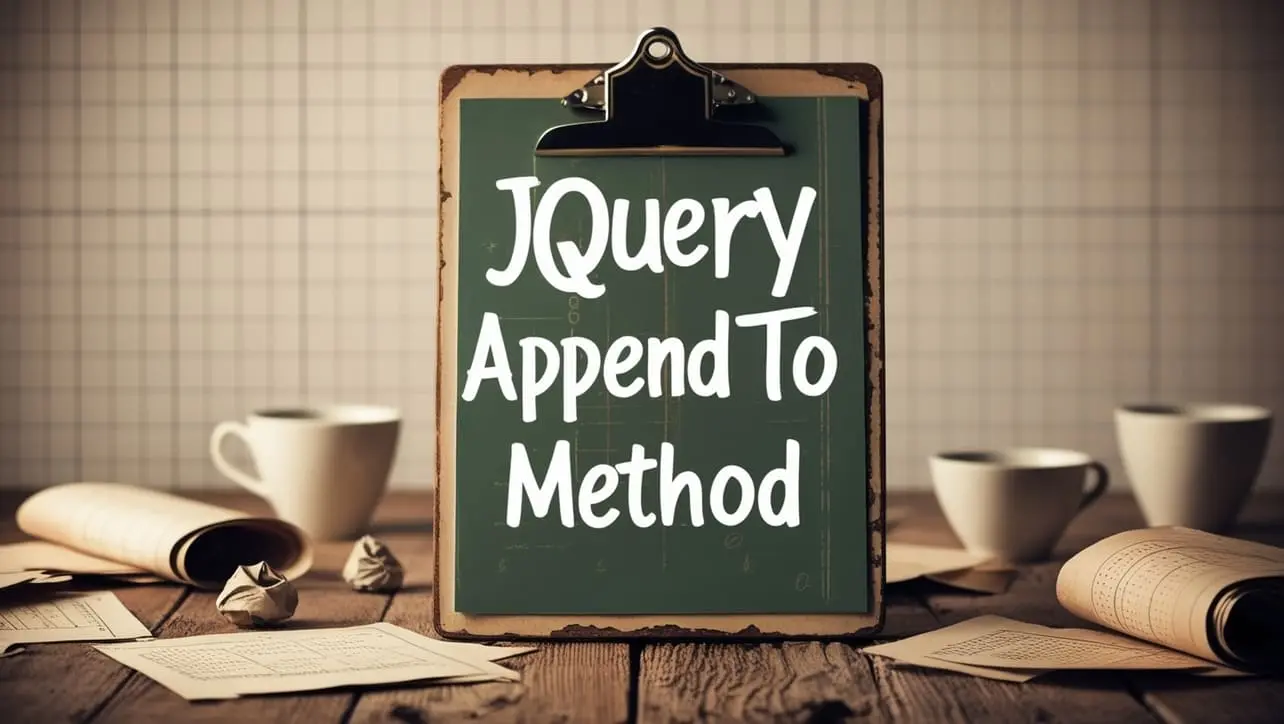
jQuery Topics
- jQuery Introduction
- jQuery Callbacks
- jQuery deferred
- jQuery selectors
- jQuery Ajax Events
- jQuery Ajax Methods
- jQuery Keyboard Events
- jQuery Keyboard Methods
- jQuery Form Events
- jQuery Form Methods
- jQuery Mouse Events
- jQuery Mouse Methods
- jQuery Event Properties
- jQuery Event Methods
- jQuery HTML
- jQuery CSS
- jQuery Fading
- jQuery Traversing
- jQuery Utilities
- jQuery Properties
jQuery .appendTo() Method

Photo Credit to CodeToFun
🙋 Introduction
In jQuery, manipulation of the DOM (Document Object Model) is made easy with a plethora of methods. One such method is .appendTo(), which allows you to insert content into other elements effortlessly. Understanding and leveraging this method can significantly streamline your web development process.
In this guide, we'll explore the jQuery .appendTo() method with clear examples to illustrate its usage and benefits.
🧠 Understanding .appendTo() Method
The .appendTo() method in jQuery is used to insert HTML content or elements into another element. It appends the selected elements as the last child of the target element(s). This method is particularly useful when you want to dynamically add content to your web page or move elements within the DOM hierarchy.
💡 Syntax
The syntax for the .appendTo() method is straightforward:
$(content).appendTo(target)📝 Example
Appending HTML Content to a Target Element:
Suppose you have a <div> element with the ID targetDiv, and you want to append a paragraph (<p>) element to it:
index.htmlCopied<div id="targetDiv">Target Div</div>example.jsCopied$("<p>Appended Paragraph</p>").appendTo("#targetDiv");This will add the paragraph element <p>Appended Paragraph</p> as the last child of the targetDiv.
Appending Existing Element(s) to a Target:
You can also move existing elements within the DOM using
.appendTo(). For example, let's move a <span> element to another <div>:index.htmlCopied<div id="targetDiv">Target Div</div> <span id="existingSpan">Existing Span</span>example.jsCopied$("#existingSpan").appendTo("#targetDiv");This will move the existing <span> element inside the targetDiv.
Appending Multiple Elements:
You can append multiple elements or pieces of content simultaneously. Let's append two list items (<li>) to an unordered list (<ul>):
index.htmlCopied<ul id="targetList"> <li>Item 1</li> <li>Item 2</li> </ul>example.jsCopied$("<li>Item 3</li><li>Item 4</li>").appendTo("#targetList");This will add two additional list items (<li>Item 3</li> and <li>Item 4</li>) to the existing list.
Chaining Methods:
jQuery allows method chaining, so you can combine multiple actions in a single line of code. For example:
example.jsCopied$("<p>New Paragraph</p>").appendTo("#targetDiv").addClass("highlight");This code appends a new paragraph to #targetDiv and then adds a highlight class to the newly appended paragraph.
🎉 Conclusion
The jQuery .appendTo() method provides a convenient way to insert content into other elements within the DOM. Whether you need to append HTML content, move existing elements, or add multiple elements at once, this method simplifies the process and enhances the dynamism of your web pages.
By mastering its usage, you can efficiently manipulate the DOM and create engaging user experiences with ease.
👨💻 Join our Community:
Author

For over eight years, I worked as a full-stack web developer. Now, I have chosen my profession as a full-time blogger at codetofun.com.
Buy me a coffee to make codetofun.com free for everyone.
Buy me a Coffee












If you have any doubts regarding this article (jQuery .appendTo() Method), please comment here. I will help you immediately.